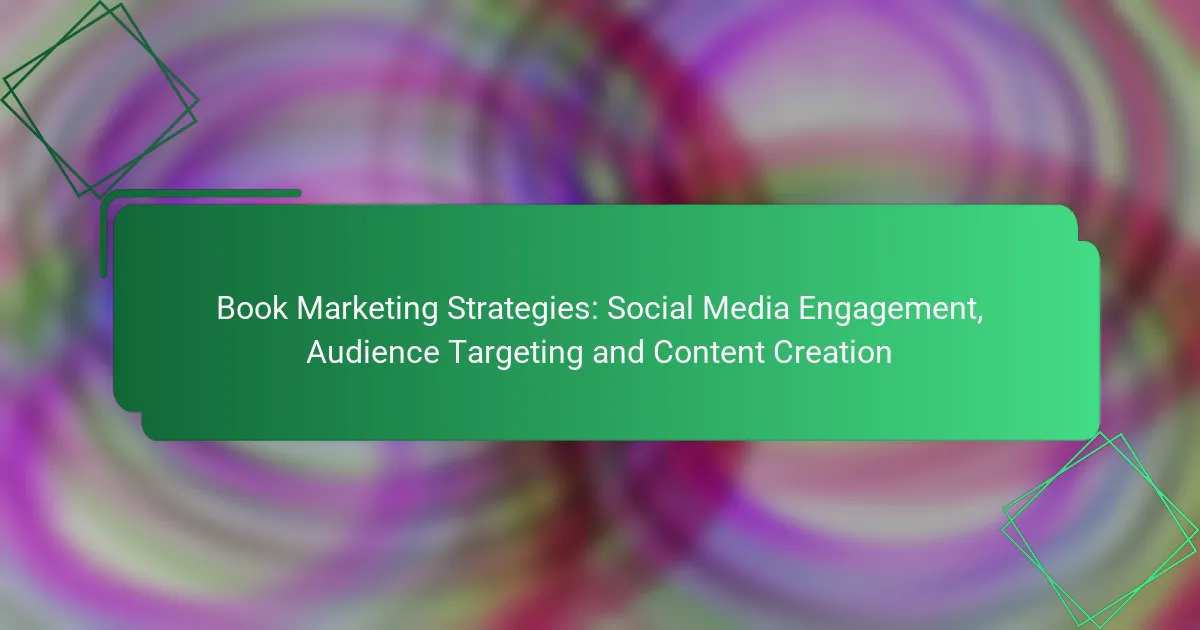In today’s digital landscape, effective book marketing strategies hinge on social media engagement, precise audience targeting, and compelling content creation. By actively connecting with readers and building a community, authors can enhance their visibility and foster loyalty. Tailoring marketing efforts to specific demographics and preferences ensures that campaigns resonate, while diverse content formats can captivate potential readers and showcase a book’s unique themes.
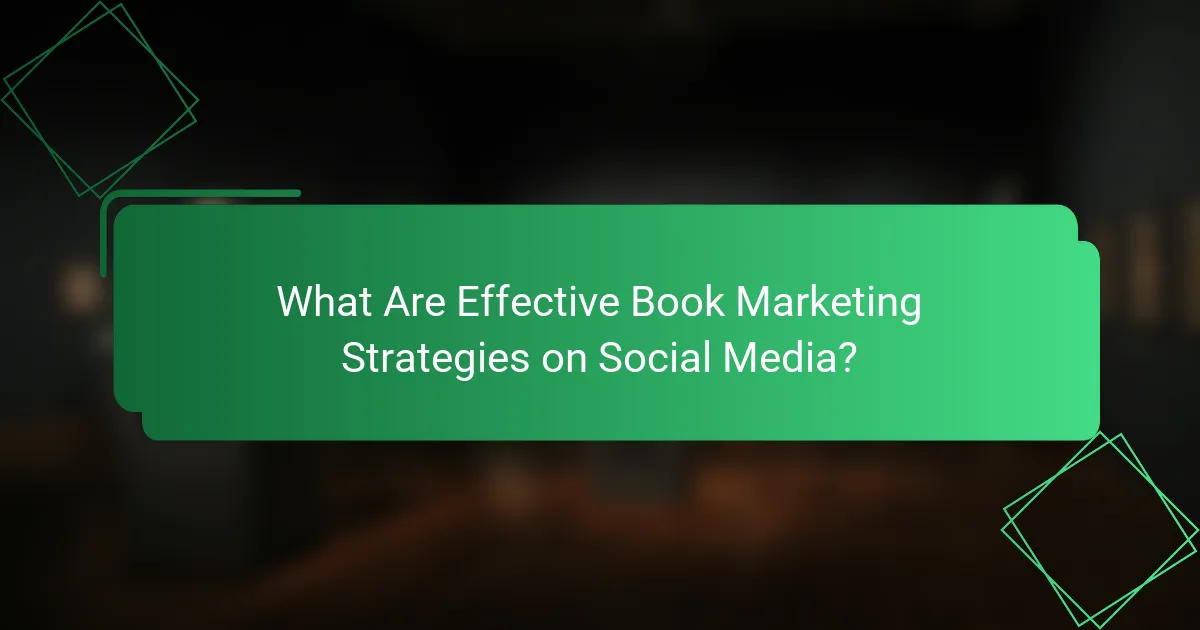
What Are Effective Book Marketing Strategies on Social Media?
Effective book marketing strategies on social media involve engaging with your audience, building a community, and creating content that resonates. By utilizing various platforms, authors can reach potential readers and foster a loyal following.
Utilizing Instagram for Visual Engagement
Instagram is a powerful platform for visual storytelling, making it ideal for book marketing. Authors can share aesthetically pleasing images of their book covers, behind-the-scenes writing processes, and quotes that resonate with their audience.
To maximize engagement, consider using Instagram Stories and Reels to showcase short video clips or interactive polls. This not only keeps your content fresh but also encourages followers to interact with your posts.
Leveraging Facebook Groups for Community Building
Facebook Groups offer a space for authors to connect with readers and fellow writers. By creating or joining groups focused on specific genres or themes, authors can share insights, gather feedback, and build a community around their work.
Engagement is key; regularly post discussion prompts, host Q&A sessions, or share exclusive content to keep group members active and interested. Avoid overtly promoting your book; instead, focus on fostering genuine relationships.
Creating Shareable Content on Twitter
Twitter is ideal for concise, impactful messaging. Authors can create shareable content by crafting engaging tweets that include quotes, writing tips, or links to blog posts about their books. Hashtags can help increase visibility and reach a broader audience.
Consider participating in Twitter chats related to your genre to connect with potential readers and other authors. Engaging with trending topics can also help your content gain traction.
Running Targeted Ads on TikTok
TikTok’s algorithm allows for highly targeted advertising, making it a valuable tool for book promotion. Authors can create short, engaging videos that highlight their books, share reading recommendations, or participate in popular challenges to capture attention.
When running ads, focus on clear calls to action and visually appealing content. Monitor ad performance and adjust targeting to ensure you reach the right audience, optimizing your budget effectively.

How to Target Your Audience for Book Marketing?
Targeting your audience for book marketing involves identifying specific reader groups and tailoring your strategies to engage them effectively. Understanding demographics, preferences, and behaviors allows you to create focused campaigns that resonate with potential readers.
Identifying Reader Demographics
Identifying reader demographics is crucial for effective book marketing. Start by considering age, gender, location, and interests to define your target audience. For instance, a young adult fantasy novel may appeal more to readers aged 15-25, while a historical romance might attract an older demographic.
Utilize surveys, social media analytics, and sales data to gather insights about your current readers. This information helps you refine your marketing strategies and develop content that speaks directly to your audience’s preferences.
Using Facebook Audience Insights
Facebook Audience Insights is a powerful tool for understanding your potential readers on social media. By entering your book’s genre or related topics, you can access data about user demographics, interests, and behaviors. This allows you to tailor your content and advertisements to better reach your target audience.
Consider creating custom audiences based on these insights. For example, if your book is a thriller, you can target users interested in similar genres, enhancing the likelihood of engagement and conversions.
Segmenting Email Lists for Personalized Campaigns
Segmenting your email lists enables personalized marketing campaigns that resonate with different reader groups. Divide your audience based on factors like reading preferences, past purchases, or engagement levels. This allows you to send tailored content that speaks directly to each segment’s interests.
For instance, if you have a series of books, you can create segments for readers who have purchased the first book and those who have not. This way, you can send reminders or exclusive offers to encourage further engagement. Regularly update your segments based on reader behavior to maintain relevance.
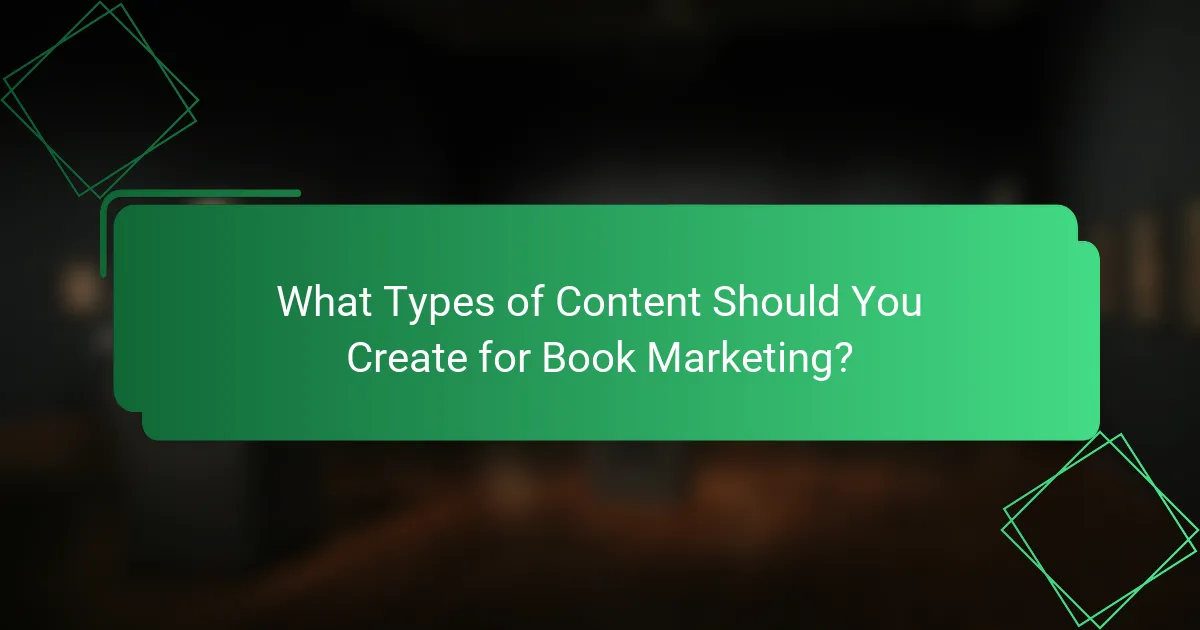
What Types of Content Should You Create for Book Marketing?
For effective book marketing, focus on creating engaging content that resonates with your target audience. This includes a mix of blog posts, video trailers, and infographics that highlight your book’s themes and attract potential readers.
Writing Engaging Blog Posts
Blog posts are a powerful tool for book marketing as they allow you to connect with readers and showcase your expertise. Aim for posts that discuss themes from your book, share behind-the-scenes insights, or provide valuable tips related to your genre.
Consider using a consistent posting schedule to keep your audience engaged. A good practice is to publish at least once a week, ensuring that each post is well-researched and offers unique perspectives.
Remember to include calls to action, inviting readers to comment or share your posts. This interaction can help build a community around your work and increase visibility.
Producing Video Trailers for Books
Video trailers can effectively capture attention and convey the essence of your book in a dynamic way. These short videos should be visually appealing and include key elements such as the book cover, a brief synopsis, and compelling visuals that reflect the story’s mood.
Keep your trailers concise, ideally between 30 seconds to 2 minutes, to maintain viewer interest. Share these videos across social media platforms and your website to maximize reach.
Utilize tools like Canva or Adobe Spark for simple video creation, or consider hiring a professional if your budget allows. Ensure that the final product aligns with your book’s branding and target audience.
Creating Infographics to Highlight Key Themes
Infographics are an excellent way to present complex information in an easily digestible format. Use them to highlight key themes, character arcs, or plot points from your book, making it visually engaging for potential readers.
When designing infographics, focus on clarity and aesthetics. Use a mix of icons, charts, and text to convey your message effectively. Tools like Piktochart or Visme can help you create professional-looking infographics without extensive design skills.
Share your infographics on social media and your blog to attract attention and encourage sharing. This can enhance your book’s visibility and drive traffic to your sales page.
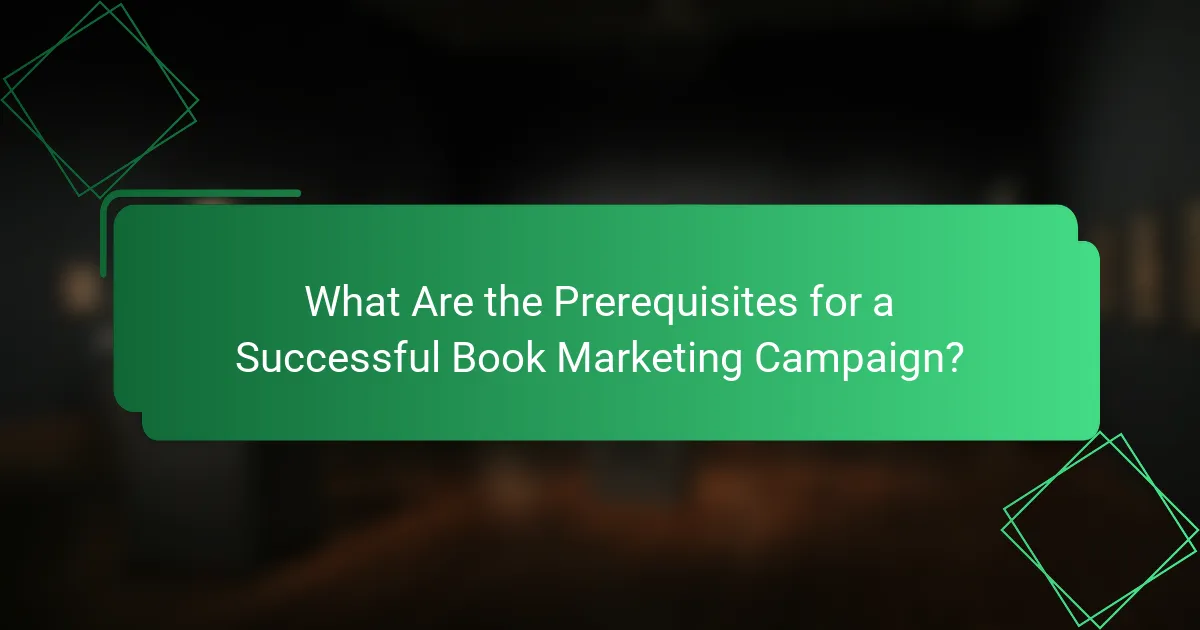
What Are the Prerequisites for a Successful Book Marketing Campaign?
A successful book marketing campaign requires a clear strategy that includes understanding your target audience, establishing a strong author brand, and building an email list prior to launch. These elements create a solid foundation for engaging potential readers and maximizing book sales.
Establishing a Strong Author Brand
Creating a strong author brand is essential for differentiating yourself in a crowded market. Your brand should reflect your unique voice, values, and the themes of your work. Consider developing a consistent visual identity, including a logo and color scheme, that resonates with your target audience.
Engage with readers through social media platforms and your website to build a community around your brand. Share insights about your writing process, personal stories, and updates about your book. Authentic interactions can foster loyalty and encourage word-of-mouth promotion.
Building an Email List Before Launch
Building an email list before your book launch is crucial for direct communication with potential readers. Start by offering a free incentive, such as a short story or a chapter preview, to encourage sign-ups. Use platforms like Mailchimp or ConvertKit to manage your list effectively.
Regularly engage with your email subscribers by sending updates, exclusive content, and launch announcements. Aim for a consistent schedule, like monthly newsletters, to keep your audience informed and excited about your upcoming release. This proactive approach can significantly enhance your book’s visibility and sales potential upon launch.
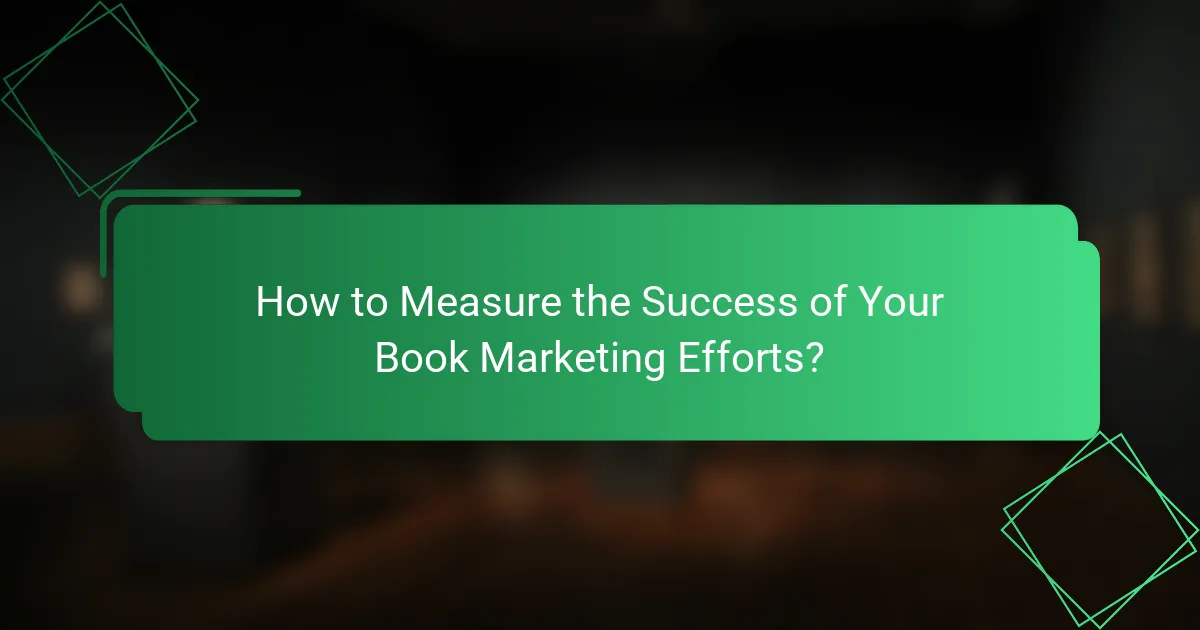
How to Measure the Success of Your Book Marketing Efforts?
Measuring the success of your book marketing efforts involves tracking various metrics to evaluate engagement, sales, and overall impact. Focus on both quantitative data, like sales figures, and qualitative insights, such as audience feedback, to get a comprehensive view of your marketing effectiveness.
Tracking Engagement Metrics on Social Media
To gauge your book’s marketing success on social media, monitor engagement metrics such as likes, shares, comments, and follower growth. These indicators reflect how well your content resonates with your audience and can guide future strategies.
Consider using tools like Google Analytics or social media insights to track these metrics over time. Aim for a consistent increase in engagement; a growth rate of 5-10% monthly can indicate effective content and audience connection.
Analyzing Sales Data Post-Campaign
After your marketing campaign, analyze sales data to determine its effectiveness. Look at total sales, revenue generated, and changes in sales patterns compared to previous periods. This analysis helps identify which strategies worked and which did not.
Utilize sales tracking tools or platforms like Amazon Author Central to gather data. A spike in sales during or shortly after a campaign can signify successful marketing efforts, while stagnant sales may suggest a need for strategy reevaluation.
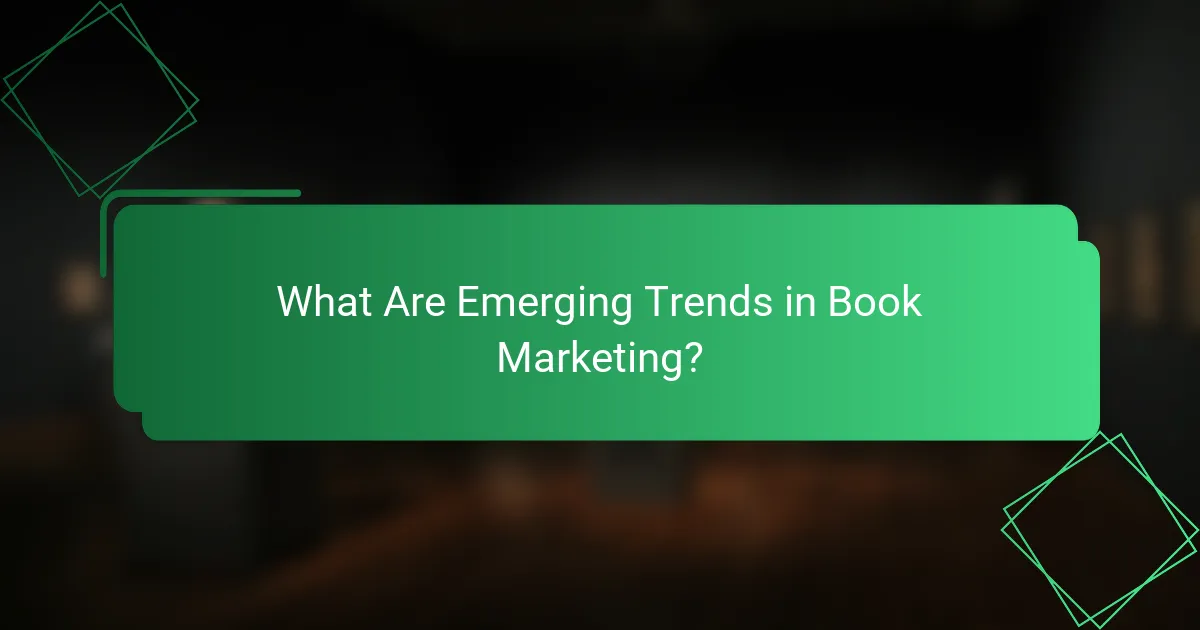
What Are Emerging Trends in Book Marketing?
Emerging trends in book marketing focus on leveraging digital platforms, engaging audiences through personalized content, and utilizing data-driven strategies. These trends emphasize the importance of social media, targeted advertising, and innovative content creation to reach potential readers effectively.
Social Media Engagement
Social media engagement is crucial for connecting with readers and building a community around your book. Platforms like Instagram, Twitter, and TikTok allow authors to share updates, behind-the-scenes content, and interact directly with their audience. Regularly posting engaging content can increase visibility and foster loyalty among readers.
To maximize social media engagement, consider using a mix of content types, such as videos, polls, and live Q&A sessions. Collaborating with influencers or other authors can also expand your reach. Aim for consistency in posting to keep your audience engaged and informed.
Audience Targeting
Effective audience targeting involves identifying and reaching the specific groups most likely to be interested in your book. This can be achieved through market research, analyzing reader demographics, and utilizing social media analytics. Understanding your audience’s preferences helps tailor your marketing efforts.
Utilize tools like Facebook Ads or Google Ads to create targeted campaigns that focus on specific interests, behaviors, or locations. Testing different audience segments can reveal which groups respond best, allowing you to refine your marketing strategy for better results.
Content Creation
Content creation is essential for attracting and retaining readers. This includes not only the book itself but also supplementary materials like blog posts, videos, and newsletters. High-quality content can establish you as an authority in your genre and keep readers engaged long after they finish your book.
Consider creating a content calendar to plan and schedule your posts across various platforms. Engage your audience with storytelling techniques, sneak peeks, or character insights. Regularly updating your content can help maintain interest and encourage readers to share your work with others.
